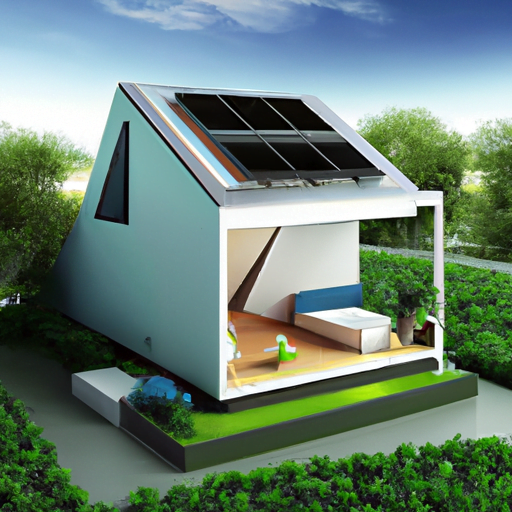Living off the grid has become increasingly popular in recent years, and one of the most sustainable ways to embrace this lifestyle is by opting for an off-grid earth home. With a focus on self-sufficiency and minimal environmental impact, these homes seamlessly integrate into their natural surroundings. From utilizing renewable energy sources to employing eco-friendly building materials, off-grid earth homes offer a sustainable and harmonious way of living that reduces our carbon footprint and promotes a greater connection with nature. In this article, we will explore the many benefits of these unique homes and why they are considered the sustainable choice for those seeking a more environmentally conscious lifestyle.
What is Off-Grid Living?
Definition of Off-Grid Living
Off-grid living refers to a lifestyle where individuals or communities are completely independent of public utilities such as electricity, water, and sewage systems. Instead, they rely on alternative sources of energy, such as solar power or wind power, and practice self-sufficiency by growing their own food and managing their waste. This way of living allows people to disconnect from traditional infrastructure and live closer to nature, reducing their environmental impact and promoting sustainability.
Key Features of Off-Grid Living
The key features of off-grid living include independence from utilities, reliance on renewable energy sources, water conservation, waste management, and the use of efficient heating and cooling systems. These features work in harmony to create a self-sustaining lifestyle that minimizes dependence on traditional energy sources and reduces the overall environmental footprint.
Benefits of Off-Grid Living
Off-grid living offers numerous benefits, including reduced environmental impact, energy and cost savings, self-sufficiency and resilience, and improved health and well-being. By disconnecting from the grid and utilizing renewable energy sources, individuals can make a positive contribution to the environment by lowering their carbon footprint. Additionally, the ability to generate their own energy and grow their own food provides a sense of self-reliance and security. Living off-grid also promotes a closer connection with nature, which has been linked to improved mental health and overall well-being.
Introduction to Earth Homes
Overview of Earth Homes
Earth homes, also known as eco homes or green homes, are residences built using natural materials and designed to coexist harmoniously with the environment. These homes utilize sustainable building practices and prioritize energy efficiency, utilizing the natural resources available in the surrounding area. From ancient cave dwellings to modern-day earthships, earth homes have a long history and are gaining popularity as a sustainable housing option.
Advantages of Earth Homes
Earth homes offer several advantages, making them an appealing choice for off-grid living. Firstly, the use of natural materials such as adobe, cob, or rammed earth provides excellent thermal insulation, reducing the need for additional heating or cooling systems. Additionally, these materials are abundant and easily accessible, reducing the carbon footprint associated with transportation. Earth homes also have a low impact on the surrounding ecosystem, as they can be built without damaging the natural landscape. Moreover, they have a unique aesthetic appeal, combining beauty and sustainability in an innovative and eco-friendly way.
Different Types of Earth Homes
There are various types of earth homes, each with its own unique characteristics and construction techniques. Some common types include adobe homes, which are made of sun-dried bricks of clay and straw; cob houses, which use a mixture of clay, sand, and straw to create walls; rammed earth homes, where a mixture of soil and stabilizers is densely packed between temporary formwork; and earthbag homes, which utilize polypropylene bags filled with earth or other natural materials. Each type of earth home offers its own set of advantages and can be adapted to suit different climates and regions.

The Importance of Sustainability
Understanding Sustainability
Sustainability refers to the practice of utilizing resources in a way that meets the needs of the present generation without compromising the ability of future generations to meet their own needs. It involves conserving resources, minimizing waste, and promoting environmental, social, and economic well-being. By embracing sustainable practices, such as off-grid living and earth homes, individuals can contribute to a more balanced and resilient future.
Environmental Impact of Traditional Housing
Traditional housing, characterized by its reliance on grid-connected utilities and conventional construction materials, has a significant environmental impact. The construction industry consumes vast amounts of energy and natural resources, resulting in greenhouse gas emissions and habitat destruction. Additionally, the operation of traditional homes relies heavily on fossil fuel-based energy sources, contributing to air and water pollution. By shifting to sustainable alternatives, such as off-grid earth homes, individuals can significantly reduce their environmental footprint and mitigate these negative impacts.
Why Sustainable Housing is Crucial
Sustainable housing plays a crucial role in addressing the challenges of climate change, resource depletion, and environmental degradation. The residential sector is a major contributor to greenhouse gas emissions and energy consumption, making it an important area to target for sustainable practices. By embracing off-grid living and earth homes, individuals can help reduce reliance on finite resources, decrease carbon emissions, and contribute to a more sustainable and resilient future for both themselves and the planet.
Key Features of Off-Grid Earth Homes
Independence from Utilities
One of the key features of off-grid earth homes is their complete independence from public utilities. These homes rely on alternative sources of energy, such as solar power or wind power, to generate electricity. They often incorporate rainwater harvesting systems and employ various methods to treat and filter water for daily use. By disconnecting from traditional utilities, off-grid earth homes offer individuals the freedom to live in remote locations and reduce their dependence on centralized infrastructure.
Renewable Energy Sources
Off-grid earth homes prioritize the use of renewable energy sources, such as solar power, wind power, hydroelectric power, and geothermal energy. Solar power is the most common renewable energy source utilized in off-grid homes, with photovoltaic panels converting sunlight into electricity. Wind power harnesses the energy of the wind to generate electricity through turbines, while hydroelectric power utilizes the flow of water to generate electricity. Geothermal energy taps into the heat stored beneath the Earth’s surface to provide heating and cooling for the home. By harnessing these renewable energy sources, off-grid earth homes can operate sustainably and reduce their reliance on fossil fuels.
Water Conservation
Water conservation is a crucial aspect of off-grid living and is carefully considered in the design of earth homes. These homes often incorporate rainwater harvesting systems to capture and store rainwater for daily needs such as drinking, cooking, and bathing. Greywater systems, which collect and treat water from sinks, showers, and laundry, are also commonly used to reuse water for irrigation purposes or flushing toilets. By conserving water in this way, off-grid earth homes significantly reduce their demand on local water sources and contribute to a more sustainable water management system.
Waste Management
Off-grid earth homes strive to minimize waste and promote sustainable waste management practices. Composting toilets are often used to convert human waste into nutrient-rich compost, which can be safely used as fertilizer. Greywater systems, as mentioned earlier, help reduce water waste and provide a means of treating wastewater on-site. Additionally, waste reduction and recycling strategies are implemented to minimize the amount of waste generated and divert it from landfills. By adopting these waste management practices, off-grid earth homes demonstrate a commitment to sustainability and responsible resource utilization.
Efficient Heating and Cooling Systems
Off-grid earth homes prioritize energy efficiency in their heating and cooling systems. The use of natural building materials, such as adobe or rammed earth, provides excellent thermal mass, helping to regulate indoor temperatures and reduce the need for additional heating or cooling. Passive solar design principles, such as strategically placed windows and proper insulation, maximize solar gain during cold months and prevent excessive heat gain during hot months. Additionally, energy-efficient appliances and lighting are utilized to minimize energy consumption. By employing these strategies, off-grid earth homes can maintain comfortable indoor temperatures using minimal energy inputs.

Renewable Energy Sources in Off-Grid Earth Homes
Solar Power
Solar power is the most common and widely used renewable energy source in off-grid earth homes. Photovoltaic (PV) panels convert sunlight into electricity, which can power all electrical needs within the home. The panels are installed on the roof or in a sunny location and are connected to a battery bank to store excess energy for use during cloudy days or at night. By harnessing the power of the sun, off-grid earth homes can generate clean and sustainable electricity without contributing to greenhouse gas emissions.
Wind Power
In locations with consistent wind patterns, wind power can be an effective renewable energy source for off-grid earth homes. Wind turbines, typically mounted on a tower, utilize the kinetic energy of the wind to generate electricity. As the wind passes through the turbine blades, they spin a generator, producing electrical energy. Just like solar power, the electricity generated can be stored in battery banks for use when the wind is not blowing. Wind power provides a reliable and continuous source of renewable energy, making it an excellent option for off-grid living.
Hydroelectric Power
For off-grid earth homes located near flowing water bodies, hydroelectric power can be an ideal renewable energy source. A hydroelectric system utilizes the force of moving water to generate electricity. Water is channeled through a turbine, which is connected to a generator, producing electrical energy. Small-scale hydroelectric systems, such as micro-hydro turbines, can be installed in rivers or streams to provide a consistent and sustainable source of power. By harnessing the power of flowing water, off-grid earth homes can generate electricity without relying on traditional energy sources.
Geothermal Energy
Geothermal energy harnesses the heat stored beneath the Earth’s surface to provide heating and cooling for off-grid earth homes. Geothermal heat pumps utilize a network of pipes buried underground to extract heat during the winter and cool air during the summer. This energy-efficient method of climate control relies on the constant temperature of the ground, which remains relatively stable throughout the year. By tapping into geothermal energy, off-grid earth homes can enjoy efficient heating and cooling without the need for fossil fuel-based systems.
Benefits of Off-Grid Earth Homes
Reduced Environmental Footprint
Off-grid earth homes offer significant reductions in environmental footprint compared to traditional housing. By utilizing renewable energy sources and implementing sustainable practices, these homes minimize greenhouse gas emissions and air pollution. Additionally, the use of natural building materials in earth homes reduces the extraction of non-renewable resources and lowers the carbon footprint associated with construction. Overall, off-grid earth homes contribute to a more sustainable and regenerative approach to housing, preserving the environment for future generations.
Energy and Cost Savings
Off-grid earth homes provide the opportunity for substantial energy and cost savings. By generating their own electricity through renewable energy sources, homeowners can eliminate or greatly reduce their monthly utility bills. The initial investment in renewable energy systems, such as solar panels or wind turbines, may require some upfront costs, but the long-term savings can be significant. Additionally, the energy-efficient design and construction of earth homes help minimize energy consumption, further contributing to cost savings over time.
Self-Sufficiency and Resilience
Living off-grid in an earth home fosters self-sufficiency and resilience. By producing their own energy, growing their own food, and managing their own resources, homeowners become less reliant on external sources. This level of independence provides a sense of security and peace of mind, especially in situations where access to traditional utilities may be disrupted. Off-grid earth homes empower individuals to take control of their lives and reduce their dependence on finite resources, promoting a more self-reliant way of living.
Health and Well-being
Off-grid earth homes have been shown to have positive impacts on the health and well-being of their occupants. The use of natural building materials, such as clay or straw, creates a healthier indoor environment by minimizing the presence of toxins or allergens. Additionally, the connection to nature and the natural surroundings of earth homes contributes to improved mental and emotional well-being. Studies have shown that spending time in nature can reduce stress, improve cognitive function, and promote overall mental and physical health. Living off-grid in an earth home allows individuals to experience these benefits more closely and consistently.

Challenges and Considerations
Initial Investment and Cost
One of the primary challenges of off-grid earth homes is the initial investment and cost associated with setting up the necessary infrastructure. Renewable energy systems, such as solar panels or wind turbines, can require a significant upfront investment. Additionally, earth homes may require special construction techniques or materials, which can add to the overall cost of building. While the long-term energy and cost savings of off-grid living can outweigh the initial expenses, it is important to carefully consider the financial implications before embarking on an off-grid earth home project.
Limited Accessibility to Amenities
Another consideration of off-grid living is the limited accessibility to amenities and services commonly found in urban areas. Off-grid earth homes are often located in remote or rural locations, which can make it more challenging to access things like medical facilities, grocery stores, or other essential services. This requires careful planning and preparation to ensure that necessary provisions are available or that alternative solutions are in place. However, living off-grid also offers the opportunity to embrace a simpler and more intentional lifestyle, connecting with nature and reducing reliance on material consumption.
Skills and Knowledge Required
Successfully living off-grid in an earth home requires a certain level of skills and knowledge. From building the home itself to maintaining and troubleshooting renewable energy systems, individuals need to have a basic understanding of construction techniques, electrical systems, and sustainable practices. While these skills can be learned and honed over time, it is important to be prepared for the learning curve and invest time and effort into acquiring the necessary expertise.
Building Codes and Regulations
Building codes and regulations can present challenges for off-grid earth homes. Traditional building codes are often designed with grid-connected housing in mind, which can make it difficult to obtain permits or approvals for alternative construction methods. However, as the popularity of off-grid living and sustainable housing grows, there is an increasing recognition of the need to adapt building codes and regulations to accommodate these innovative approaches. It is important for individuals interested in off-grid earth homes to research local regulations and engage with relevant authorities to ensure compliance and avoid potential setbacks.
Success Stories of Off-Grid Earth Homes
Case Study 1: Earthship Biotecture
Earthship Biotecture, founded by Michael Reynolds, is an internationally recognized leader in off-grid earth homes. Earthship homes are built using recycled materials, such as tires and bottles, and incorporate sustainable design principles to create self-sustaining structures. These earthships specialize in utilizing solar power, rainwater harvesting, and on-site food production to achieve complete off-grid living. Earthship Biotecture has successfully constructed earthship communities in various locations around the world, showcasing the possibility and potential of off-grid earth homes to create sustainable, resilient, and regenerative communities.
Case Study 2: The Hobbit House
Inspired by J.R.R. Tolkien’s hobbit homes, Simon Dale created his own off-grid earth home in Wales. Using local and natural materials, such as straw bales, clay, and reclaimed wood, Dale built his home with a focus on sustainability and self-sufficiency. The Hobbit House features a green roof, solar panels for electricity, and a composting toilet. This unique and whimsical off-grid earth home showcases the creativity and adaptability of the concept, proving that sustainable living can be both functional and beautiful.
Case Study 3: The Ziegel House
The Ziegel House, located in Germany, is an example of an off-grid earth home that embraces sustainable and energy-efficient design. Constructed using rammed earth walls, the home boasts excellent thermal insulation properties. The house utilizes a combination of renewable energy sources, including solar power and a ground-source heat pump, to provide electricity, heating, and cooling needs. In addition to its environmentally friendly features, the Ziegel House has a modern and minimalist design, demonstrating that sustainable living can be both practical and aesthetically pleasing.

Conclusion
Summary of Off-Grid Earth Homes
Off-grid earth homes offer a sustainable alternative to traditional housing by prioritizing self-sufficiency, renewable energy sources, and environmentally conscious practices. These homes are designed to minimize environmental impact, conserve resources, and create a healthier and more resilient way of living. By embracing off-grid living and earth homes, individuals can significantly reduce their carbon footprint, save energy and costs, and promote a more sustainable future for themselves and the planet.
Promoting Sustainable Living
The adoption of off-grid earth homes is a crucial step towards promoting sustainable living. By showcasing the benefits, challenges, and success stories of off-grid living, individuals and communities can be inspired to embrace these innovative housing solutions. Sustainable living not only benefits individuals by reducing their environmental impact and increasing self-sufficiency but also contributes to the collective effort in combatting climate change and building a more sustainable future.
Future Potential of Off-Grid Earth Homes
The future potential of off-grid earth homes is promising. As society continues to recognize the importance of sustainability and the need for alternative housing solutions, the demand for off-grid living options is likely to increase. Advances in technology, construction techniques, and regulatory frameworks will further support the development and mainstream adoption of sustainable housing. With continued innovation and education, off-grid earth homes have the potential to become a mainstream and accessible choice for individuals seeking a sustainable lifestyle.




